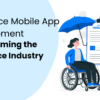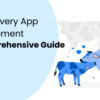In the era of digital transformation, the insurance sector has embraced technology to enhance customer experiences, streamline operations, and increase efficiency. One of the most significant advancements is the development of insurance mobile apps, which allow customers to access services anytime, anywhere. This article explores the features, benefits, and steps involved in insurance mobile app development, as well as emerging trends shaping the future of the industry.
Why is an Insurance Mobile App Important?
An insurance mobile app bridges the gap between insurance providers and customers by offering convenient access to policies, claims, and other services. With an increasing number of users relying on smartphones for everyday tasks, having a mobile app has become essential for insurance companies to remain competitive.
Key Benefits of Insurance Apps:
- Enhanced Customer Experience: Simplified processes for policy purchases, claims filing, and renewals.
- Operational Efficiency: Automated workflows reduce manual errors and processing times.
- Customer Retention: Personalized services and 24/7 accessibility improve satisfaction and loyalty.
Key Features of an Insurance Mobile App
A successful insurance mobile app incorporates features that simplify processes for users while ensuring security and transparency. Here are the must-have features:
1. User Registration and Profile Management
- Easy sign-up via email, phone number, or social media accounts.
- User profiles to manage personal details, linked policies, and preferences.
2. Policy Management
- Options to view, purchase, and renew policies within the app.
- Access to detailed policy documents and terms.
3. Claims Filing and Tracking
- Simplified claims filing with document uploads and digital signatures.
- Real-time tracking of claim statuses for transparency.
4. Payment Integration
- Secure payment gateways for premium payments and renewals.
- Multiple payment options, including credit cards, UPI, and e-wallets.
5. Chatbots and AI Assistance
- AI-powered virtual assistants for answering queries and guiding users through processes.
- 24/7 customer support with chat and call options.
6. Push Notifications
- Timely reminders for policy renewals, premium payments, and claim updates.
- Personalized offers and promotions based on user behavior.
7. Document Upload and Storage
- Digital lockers to store policy documents, ID proofs, and claims-related files.
- Easy sharing of documents during claims processes.
8. Multi-Language Support
- Support for multiple languages to cater to a diverse audience.
9. Geo-Location Services
- Locate nearby branches or agents.
- Emergency assistance for vehicle or health insurance claims.
10. Analytics Dashboard
- Insights into policy performance, claim history, and premium trends for users.
Steps to Develop an Insurance Mobile App
1. Market Research and Planning
Understand the needs of your target audience and identify gaps in existing apps. Create a roadmap for features, technology stack, and budget allocation.
2. Choose the Right Technology Stack
Select reliable technologies to ensure your app’s performance, scalability, and security.
- Frontend: React Native, Flutter
- Backend: Node.js, Ruby on Rails, Django
- Database: MySQL, MongoDB
- Payment Integration: Stripe, Razorpay, PayPal
3. Design the User Interface (UI/UX)
Develop an intuitive, visually appealing design that ensures seamless navigation and enhances the user experience.
4. Develop the Core Features
Focus on building the app’s essential features, such as policy management, claims processing, and secure payments. Ensure the app is compatible with both Android and iOS platforms.
5. Ensure Data Security
Implement advanced security measures, including encryption, two-factor authentication, and secure APIs, to protect user data and comply with industry regulations.
6. Testing and Quality Assurance
Conduct rigorous testing to identify and fix bugs or performance issues. Ensure the app works smoothly across various devices and operating systems.
7. Launch and Market the App
Deploy the app on Google Play Store and Apple App Store. Use digital marketing strategies like SEO, PPC, and social media campaigns to promote the app.
Benefits of an Insurance Mobile App for Companies
1. Increased Customer Engagement
Apps provide a direct communication channel, keeping customers engaged through notifications, updates, and personalized services.
2. Streamlined Operations
Automating processes like policy renewals and claims filing reduces manual intervention and operational costs.
3. Competitive Advantage
A feature-rich app helps insurers stand out in a crowded market and attract tech-savvy customers.
4. Data Insights
Mobile apps collect valuable data on customer behavior, helping companies tailor their services and marketing strategies.
Emerging Trends in Insurance Mobile App Development
1. Artificial Intelligence (AI)
AI-powered chatbots and predictive analytics enhance customer support and improve decision-making.
2. Blockchain Technology
Ensures transparency and security in transactions and claims processing.
3. Internet of Things (IoT)
Connected devices like smart home systems and wearable health trackers provide real-time data for insurance policies.
4. Augmented Reality (AR)
AR technology enables virtual inspections and interactive tutorials for policyholders.
5. Pay-as-You-Go Insurance
Dynamic pricing models that adjust premiums based on user behavior, such as driving habits or health metrics.
Conclusion
Investing in insurance mobile app development is a game-changer for insurance companies looking to stay competitive and cater to evolving customer needs. By incorporating advanced features and leveraging cutting-edge technologies, businesses can provide seamless services, improve customer retention, and optimize operational efficiency.











Add comment